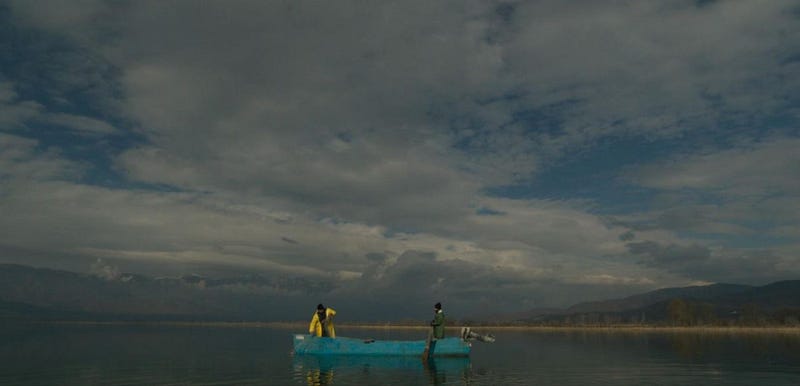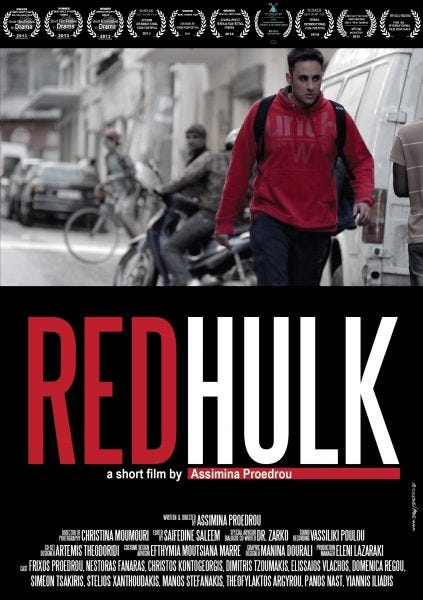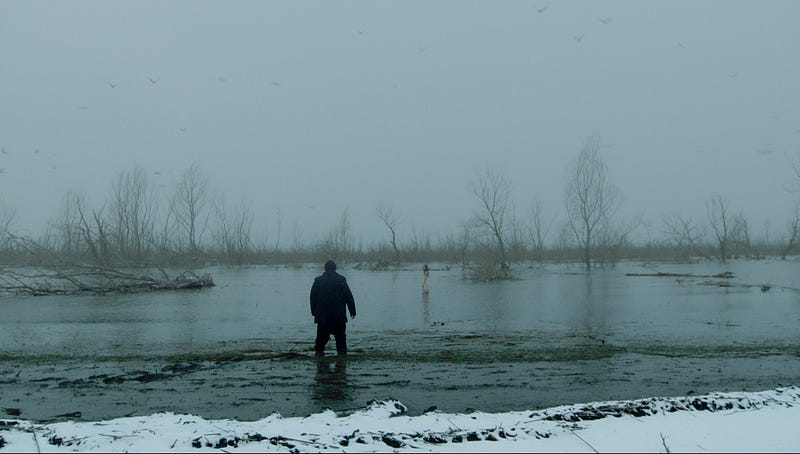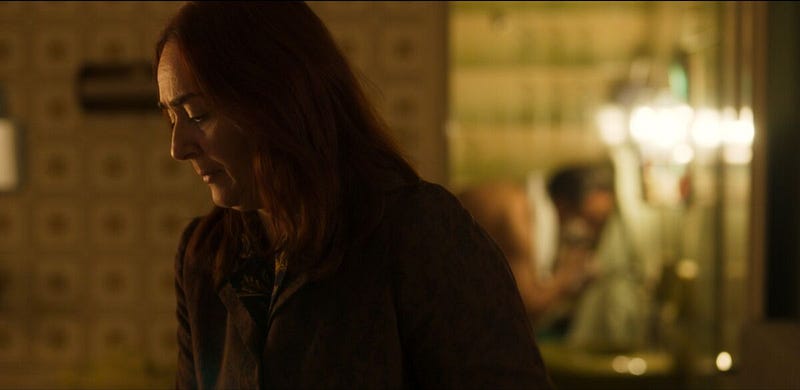29.06.2023
Where arthouse cinema meets box office success: behind the scenes of “Behind the Haystacks” with Asimina Proedrou
Moving image
When your first feature film snatches six awards at the Thessaloniki Film Festival, plays continuously for more than five months in cinemas and wins 10 awards (out of a record number of 17 nominations) in the recent Iris Awards of the Greek Film Academy, including Best Picture and Best Director, then you can be pretty sure you have directed the film of the year and the undisputed favourite to represent Greece in the nominations for the upcoming International Oscar.
Asimina Proedrou’s Behind the Haystacks confirmed the expectations created by Red Hulk, the first short film she directed in 2013, proving that one doesn’t necessarily have to choose between commercial and art cinema and that a strong story told through a confident and mature directorial vision can pave the way to a poignant, nuanced and ambitious neo-realistic drama which can appeal to international audiences while addressing topical and thorny issues of the Greek society — for example, the refugee problem and the financial crisis.
The director and SNF ARTWORKS Fellow (2022) in Moving Image talked to us about her journey and the challenges a young filmmaker faces in order to realize her artistic vision both in Greece and abroad.

The beginning of it all
I too have a very cliché story to tell about how I fell in love with cinema. When I was ten, I watched Tornatore’s Cinema Paradiso on TV and started telling everyone that I wanted to be a film director. I was completely fascinated by the world of cinema. In high school, I went to see Kiarostami’s Τhrough the Olive Groves, but as we had to leave the theatre unexpectedly, for many years to come I couldn’t remember which film it was that had captivated me to that extent. When I was in high school, it was not yet possible to receive a higher education in cinema — the first university department was founded later, in Thessaloniki — and then there was the typical fear of my parents about getting involved with the arts. So for reasons that even I don’t understand, I ended up at the Athens University of Economics and Business, and even did a postgraduate degree there. I worked for fourteen years in the private sector as an economist. I started studying film while I was working. With the first film project I made at school, a short film called Facets of Loneliness, I earned a scholarship. My teacher, Antonis Kokkinos, even told me to work on the sound and submit it to festivals. When Elektra Venaki organized an online festival, this is exactly what I did. Facets of Loneliness won the Audience Award. The prize — among other things — included a scholarship to pursue further studies. At the second school I attended, I completed Red Hulk and immediately afterwards I did a Master’s in directing, where I began writing Behind the Haystacks.

Red Hulk and first moment of recognition
The concept for the film came about when Dimitris Panagiotatos, a teacher at the school I was attending at the time, gave us three-minute exercises on murder as assignments. As I have long been preoccupied with xenophobia and racism, my idea was to propose something on racist violence. This exercise became the beginning of the film, the first few minutes of the film. Somewhere along the way, I realized that I wanted to say something else, that I wanted to explore how far people are prepared to go in order to feel that they belong somewhere. The success the film had in Drama International Short Film Festival is not really something I expected, but I certainly did try tooth and nail.
The inspiration for Behind the Haystacks
The original inspiration for the film, back in 2014, was to explore how everyday people get caught up in a system of corruption. From the beginning, I had the idea to develop three different points of view from member of the same family. Around that time, a friend happened to talk to me about Lake Doiran, which I had never visited. I googled it, saw photos of the place, and realized I had found my filming location. I just upped and left, and travelled to Lake Doiran to do research. At the time, the hotel in the area was hosting thirty Syrian refugees. I saw the way the local community treated them and visited Idomeni. That’s how Behind the Haystacks started taking shape.

The time-consuming and demanding process of making such an ambitious film
The first draft of Behind the Haystacks was completed at the end of 2015 and the proposal to the Hellenic Centre was submitted in 2017. We participated in various script labs in Sarajevo, Berlin, First Film First, and the script was constantly changing shape. Shooting began and was completed during the second lockdown, the first months of 2021. I think I was completely unaware of the danger, though, as a general rule, I find challenges exciting. We had a good budget for a first-time director’s film, but the demands of the script were enormous. We set up fifty different locations, tried to create an entire camp with just seventeen tents, and performed incredible magic tricks to ensure the film’s production value. The choice of framing was, to be sure, linked to the financial constraints we faced. However, it was also a stylistic choice that I feel responded fully to the needs of the narrative.
The difference between shooting a short film and a feature
The scale is just completely different. The first difference is how long it takes to shoot. In the case of Red Hulk, it took just seven days. For Behind the Haystacks, it took thirty-three. But filming itself is also completely different. While shooting Haystacks, I lived for months in a rhythm of the utmost creativity and excitement. We worked non-stop, with very few hours of sleep and ten-hour filming sessions per day that required absolute concentration from shot to shot. After filming was over, we had to resolve countless technical and artistic issues, constantly revising and improving things. But in all this incredible alertness, you don’t even notice the fatigue.

The perfectionism of the final cut
I’m too much of a perfectionist. I think, if they’d let me, I’d never finish the film. Luckily, though, in this life there are deadlines and budgets to observe. Post-production was also a very demanding process. Because of the complex narrative of the film and the a triple point of view that frames it, we tested the reactions of viewers, friends and acquaintances to understand what people actually make of the film, whether they are used to watching more challenging films or not. We wanted to find out whether what we wanted to say was getting through. We made several changes in that direction. To give you an example, when the film was almost finished, we decided to add the intermediate titles “Chapter I”, “Chapter II”, “Chapter III”, and “Epilogue”, to make it clearer to a wider audience that the film is divided into three parts, representing different points of view. Another important change was that we changed the English subtitles to make the film more accessible to international audiences. I have often thought about how much we, in Greece, understand when we watch foreign films, and how much the subtitles take away from the film.
Festivals and distribution: a difficult equation
Usually, a Greek film tries its luck at the big international festivals for a year, and then completes its course in Thessaloniki. In our case, because of Covid and the enormous pressure it put on the market, we took the bold and unorthodox decision to premiere in Thessaloniki instead of sitting around and waiting for an entire year.
We are very pleased we did so. What we certainly didn’t expect in Thessaloniki was the response of the people. Not only did the film fill the theatres, but nobody left during the Q&A session held after the first screening, and there was an incredible feeling of excitement and enthusiasm both inside the theatre and when we came out.
Then came the awards and all the buzz from the Thessaloniki festival, which created a word of mouth that helped get the film to a wider audience. Behind the Haystacks was released in 35 theaters in its first week, a number I personally found daunting at first but, in retrospect, it looks like it was the right decision.
I feel that we are expected to work in a market where stereotypes and strict distinctions between commercial and art cinema abound, and where anything that deviates from what is considered customary is met with suspicion and reluctance. The market — especially the international market — is comfortable operating with relative safety without deviating particularly from already existing norms. Of course, within this context, there is a part of the market that takes many more risks.
The discussion about female gaze in cinema
I believe that every filmmaker has their own perspective. Clearly, there are biological factors that will determine how they choose or approach their subjects, but this is not as clear-cut. I don’t always agree with the way the discussion on the female gaze is conducted. There are male filmmakers who approach “female” issues with sensitivity and empathy, women who approach “male” issues with similar sensitivity, and others who simply reproduce a male perception of what it means to have a female gaze. In any case, I think there are as many perspectives as there are people.
Future plans
I’m already developing the scripts for two features films and the pilot for a mini-series. I believe that series can be an area through which to expand the narrative language, especially in terms of character development. What I’m interested in is ensuring the quality of my work. I’m not interested, at least for now, in doing something abroad, because Greece is where my subjects are and I want to make Greek films. How can I develop characters from cultures I don’t know? Why would I talk about a family in Germany? What would my artistic motive be if I were to do something like this?
The struggle of being a filmmaker in Greece
The problem in Greece, as always, is that you can’t make a living just by doing cinema. It’s very, very difficult to make ends meet by making a film every three, five, or seven years. I would like to be able to make beautiful films and live off them. I think that’s an extremely ambitious goal — possibly unattainable.
Survival kit for young filmmakers
I don’t like to give advice because everyone draws their own course and is free to do what they want. Not to mention that there are many paths and many different ways which can get you where you want to be. I would tell young filmmakers to keep their originality intact and not be influenced by others. Then again, if they don’t want to, that’s their right too. I don’t know… forget the bit about originality. It just takes a whole lot of patience and effort, that’s all.
Asimina Proedrou was born in 1982, in Athens, Greece. She studied music (2001), economics (BA in 2005 and MSc in 2007, both from the Athens University of Economics and Business) and film directing (BA awarded by the Athens Metropolitan College in 2013, and MA from Staffordshire University in 2016). Her short film, Red Hulk (2013), which she wrote, directed and produced herself during her undergraduate studies, was awarded a Golden Dionysus at the Drama International Short Film Festival (2013) and won the Best Short Film Award at the 2013 Athens International Film Festival. Red Hulk was officially selected for more than sixty international film festivals, including the Clermont-Ferrand International Short Film Festival (International Competition, 2014), winning nine awards in total. Her debut feature film Behind the Haystacks, scheduled to be released in 2022, has been developed through the programs Script Station — Talents Sarajevo (2015); Script Station — Talents Berlinale (2016); and First Film First Goethe-Institut Young Directors Academy (2016–2017), while it has also won a development grant by the French Centre National du cinéma et de l’Image animée at the Crossroads Co-production Forum of the 57th Thessaloniki International Film Festival. The film is a Greek/German/North Macedonian co-production, supported, among others, by the following organizations and programs: Greek Film Center, Hellenic Broadcasting Corporation, Creative Europe Media, Southern Eastern Europe Cinema Network, the North Macedonian Film Agency, ZDF-Arte and the EU cultural support fund Eurimages. She has been awarded the Stavros Niarchos Foundation Artist Fellowship by ARTWORKS (2022).
Tassos Chatzieffraimidis is a lawyer and a freelance writer based in Athens. He currently works as a film curator at Cinobo, a digital platform dedicated to independent and arthouse cinema.



